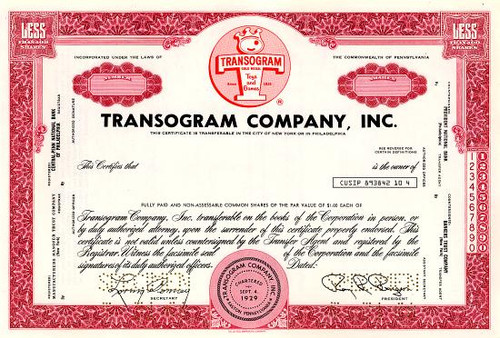Beautifully engraved Certificate from the famous Onieda, Ltd issued in 1969. This historic document was printed by the American Banknote Company and has an ornate block border with a vignette of John Humphrey Noyes, the founder of the Oneida Community, and the Mansion House in Kenwood, where the members of the Community lived. This certificate has the printed signature of Pierrepont (Pete) Noyes is over 34 years old. 
Certificate Vignette Oneida Ltd. is the world's largest stainless steel and silverplated flatware maker. Its operations in the United States, Canada, Mexico, the United Kingdom, and Italy manufacture and market sterling, silver-plated, and stainless products, and commercial china tableware. Oneida also markets tableware and crystal gift items. The company originated in a utopian community established in the mid-nineteenth century, and has had a strong reputation for quality since that time. The Oneida Community was founded by John Humphrey Noyes in upstate New York in 1848. The Community was founded on Noyes' theology of Perfectionism, a form of Christianity with two basic values: self-perfection and communalism. These ideals were translated into everyday life through shared property and work as well as Complex marriage - monogamous marriage was abolished, and children were raised communally from their second year until age 12. The Oneida Community existed longer than most other utopias of the nineteenth century in part because of the solvency of its businesses, and the members of the group lived and worked together from 1848 until the late 1870s. Prosperity didn't shield the organization from conflict, however, and in 1879 the Community split into two factions. Unable to resolve their differences, the members voted to transform the group's businesses into a joint-stock company, the Oneida Community, Limited, which would be owned and operated by former members of the society. The Community was valued at $600,000 and stocks were distributed according to each member's original contribution and length of service. The stock was divided among 226 men, women, and children, the majority of whom received between $2,000 and $4,999 in shares. The progressive nature of the new company was reflected in, among other things, the presence of a woman, Harriet Joslyn, as superintendent of the silk mill and a member of the board of directors. During the fifteen years following Oneida's reorganization, the company's financial standing deteriorated. A severe depression in the 1890s, inadequate leadership, and emigration from the community plagued the new company. Some have speculated that the failure of the utopian community contributed to demoralization of the worker/stockholders, further eroding the company's prospects for success. But in January 1894, Pierrepont Burt Noyes (P.B. Noyes), the son of Oneida's founder, rejoined the company after working as an Oneida wholesaler in - The World - as many Oneidans referred to the world outside their community. At only 23 years old, P.B. Noyes replaced an uncle on Oneida's board of directors. His experience outside the Community enabled him to see and criticize weaknesses that threatened the company's existence. Within two months Noyes led a proxy fight to oust directors who clung to old-fashioned business strategies. Nearly 24,000 shares were voted, and Noyes' side won by just 16 shares. Noyes was offered the position of superintendent at Oneida's Niagara Falls Plant, and soon raised the operation's standards of quality to their former levels. In 1899 the company announced its largest profits to date and paid its stockholders a dividend of seven percent. By the time he reached the age of thirty, Noyes had risen to de facto control of Oneida. The board nominated him to the newly created post of general manager with authority to oversee all of the company's divisions: canning and manufacturing of tableware, traps, chains, and silk thread. Noyes' rise to prominence at Oneida marked the company's emergence into the industrial world of the twentieth century. Before the turn of the century Oneida had relied on its managers' creativity, thrift, and diligence and the excellent reputation of its products. In 1977 Oneida moved to diversify its interests through the purchase of the Camden Wire Co., Inc. Camden Wire was one of the principal U.S. manufacturers of industrial wire products. One year later Oneida acquired Rena-Ware, a cookware manufacturer with operations in 34 countries and the majority of sales outside the United States. That year the company also got a new president, John Marcellus, Jr., who had joined Oneida in 1946. Pete Noyes continued as chairman until 1981, when Marcellus also assumed that position. By 1983 the company sold over half of all flatware purchased in the United States. The company sought to purchase other companies in order to infiltrate the total tableware market. Oneida purchased Buffalo China, Inc., one of the nation's largest volume producers of commercial chinaware, and Webster-Wilcox, a producer of expensive holloware (silver serving platters). In 1984 the company acquired D. J. Tableware, maker of high quality flatware, holloware, and china for the food service industry. Oneida also began to market a line of crystal stemware and giftware in the mid-1980s. The latter part of the decade saw several further changes at Oneida in management as well as business approaches. In 1986 John Marcellus retired as chairman and president. William Matthews, previously the company's general counsel, was named chairman and CEO, while Samuel Lanzafame, who previously headed the Camden Wire subsidiary, was named president. In addition, Gary Moreau, who had accumulated broad management experience since joining the company in 1977, became executive vice president of the Oneida Silversmiths Division, the company's core unit. Meanwhile, Oneida responded to shifting market conditions by re-addressing the production of lower-end, less expensive flatware. Like many domestic manufacturers, Oneida had lost much of this business segment to import competition. However, a renewed emphasis on these high-volume lines provided Oneida with a strong complement to its more expensive flatware selections, and also enabled the company to make fuller use of its factories. But while the company has clearly shown it can compete with imports at all levels, the higher-end flatware lines remain today the most important part of Oneida's business. Also during this period, Oneida made additional adjustments in subsidiary operations. After selling the Rena-Ware holding in the early 1980s, a few years later the company became majority owner of Oneida International, Inc., a joint venture formed to market Italian-designed tabletop products. The products are sold in the international foodservice market through an Italian subsidiary, Sant'Andrea S.r.l. On the domestic front, the Kenwood Silver subsidiary expanded its network of retail factory store outlets located in resort and destination shopping areas; the stores sell Oneida's excess inventory along with discontinued items and factory seconds. Within the company, worker loyalty was enhanced by the creation of an Employee Stock Ownership Plan in 1987 that put 15 percent of Oneida's stock in employees' hands. From the late '80s into the early '90s, Oneida invested more than $100 million into plant improvements, including computer design and manufacturing systems, plant consolidation, and machinery upgrades. This certificate looks great framed and is much nicer in person than the scan indicates.

Certificate Vignette













